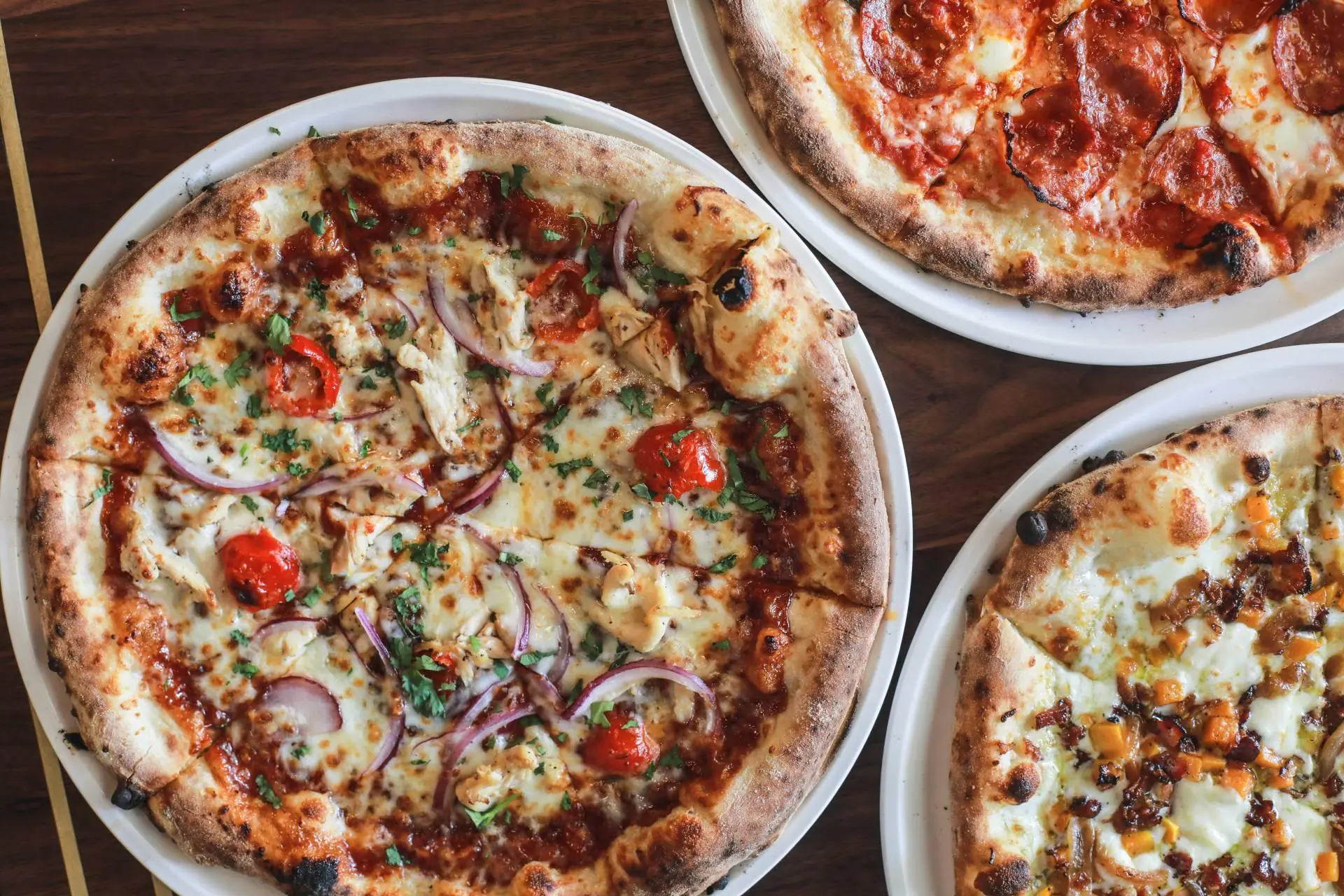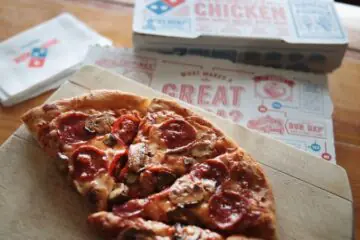In a comparison between a 10-inch and a 14-inch pizza, the main difference lies in their size. The 10-inch pizza is smaller, while the 14-inch pizza is larger.
When deciding between the two, consider the number of people you’re serving and individual appetites. A 10-inch pizza typically serves 1-2 people, while a 14-inch pizza can serve 2-3 people. A larger pizza offers more slices and a wider variety of toppings.
On the other hand, a smaller pizza may be more suitable for individuals with smaller appetites or if you want to enjoy multiple flavors. Ultimately, the choice depends on your preferences and the number of people served.
Size Matters: Understanding The Difference
Looking to settle the debate between a 10-inch and 14-inch pizza? This article breaks down the size differences between the two, helping you understand which option fits your pizza cravings.
****
When it comes to ordering pizza, the choices seem endless. From toppings to crust thickness, there are plenty of factors to consider. But one of the most important decisions you’ll face is the size of your pizza. Should you go for a 10-inch or a 14-inch?
Let’s dive into the dimensions, serving sizes, and how the size impacts your dining experience.
The Dimensions And Serving Size Of A 10-Inch Pizza:
- 10-inch diameter: A 10-inch pizza measures 10 inches from one end to the other. This smaller size is great for individuals or small gatherings.
- Serves 1-2 people: With a 10-inch pizza, you can comfortably serve one to two people. It’s perfect for an intimate dinner or a quick lunch.
The Dimensions And Serving Size Of A 14-inch Pizza:
- 14-inch diameter: A 14-inch pizza has a diameter of 14 inches, making it significantly larger than its 10-inch counterpart. This size is great for larger groups or gatherings.
- Serves 3-4 people: With a 14-inch pizza, you can easily feed a small group of three to four people. It’s ideal for a night in with friends or a family dinner.
How the size impacts your dining experience:
- Variety of slices: A larger 14-inch pizza means more slices. The larger size allows for more options if you have a diverse group of eaters with varying preferences.
- Toppings distribution: The toppings are spread over a larger surface area with a larger pizza. This allows for a more balanced and even distribution, ensuring that each bite is as delicious as the last.
- Portion control: If you’re watching your portion sizes or counting calories, a 10-inch pizza provides a smaller serving size. It can help you maintain portion control and prevent overeating.
- Leftovers: A larger 14-inch pizza often results in leftovers. If you enjoy having pizza for lunch the next day or a midnight snack, the bigger size allows for more indulging opportunities.
- Value for money: When it comes to value for money, a 14-inch pizza offers more bang for your buck. The larger size provides more servings, making it a cost-effective option.
Choosing between a 10-inch and a 14-inch pizza is all about understanding your needs and preferences. If you’re dining alone or with one other person, a 10-inch pizza may be the perfect choice. But if you’re feeding a group or looking for leftovers, a 14-inch pizza is the way to go.
Size does matter when it comes to pizza, so consider the dimensions, serving sizes, and how they impact your dining experience before making your decision. Enjoy your pizza feast!
Crust, Toppings, And Flavor: How Size Impacts Pizza Quality
Discover how the size of a pizza impacts its quality. From crust and toppings to flavor, learn how a 10-inch pizza compares to a 14-inch one in terms of taste and satisfaction.
Pizza lovers often ponder the age-old question: does pizza size matter? When choosing between a 10-inch and a 14-inch pizza, the differences in crust, toppings, and overall flavor can significantly impact your taste buds’ experience.
In this section, we will dive into how the size of a pizza affects these crucial elements, shedding some light on the intense debate surrounding this topic.
The Impact Of Size On Crust Thickness And Texture:
- A smaller pizza, such as a 10-inch, tends to have a thicker crust than its larger counterpart.
- On the other hand, the crust of a 14-inch pizza tends to be thinner, offering a delightful crunch when bitten into.
- The pizza’s size influences the dough’s distribution, providing varying textures and mouthfeel with each bite.
- Smaller pizzas offer a more dough-centered experience, while larger pizzas balance the dough-to-topping ratio, producing a crispier crust.
How The Size Affects The Distribution Of Toppings:
- Larger pizzas, like the 14-inch ones, provide more surface area for toppings to spread evenly.
- The distribution of toppings on a 10-inch pizza may be more concentrated, making each bite burst with flavor.
- Smaller pizzas with fewer toppings allow for a more intimate encounter, while larger pizzas offer a delightful explosion of flavors.
Does The Size Influence The Overall Flavor Of The Pizza?
- The size of a pizza plays a part in how our taste buds experience flavors.
- A smaller pizza allows the flavors of each element to meld together more intimately, intensifying the overall taste profile.
- While a 14-inch pizza may dilute the flavors slightly due to its larger size, it compensates with a wider range of toppings, enhancing the overall flavor experience.
- Ultimately, choosing between a 10-inch and a 14-inch pizza depends on personal preference and the desire for varied flavor combinations.
Now that we’ve delved into the impact of size on the crust, toppings, and overall flavor, you can make an informed decision about your pizza size preference. Whether you opt for the thick and doughy experience of a 10-inch pizza or crave the crispy crust and flavorful indulgence of a 14-inch pizza, remember that size matters when enjoying this beloved culinary delight.
Portion Control And Satisfying Cravings
Discover the benefits of portion control and satisfying cravings with a 10-inch vs. 14-inch pizza. Find out how the size of your pizza can impact your appetite and help you maintain a healthy balance. Choose wisely and enjoy your slice guilt-free!
The Portion Size Of A 10-Inch Pizza Versus A 14-Inch Pizza
When it comes to pizza, size matters. The portion size of a 10-inch pizza and a 14-inch pizza can make a significant difference in satisfying cravings and determining how much you indulge. Let’s take a closer look at comparing these two popular pizza sizes.
- Smaller but satisfying:
- A 10-inch pizza may seem compact, but it can satisfy your cravings, especially if you prefer a smaller portion or dining alone.
- Its smaller size allows for better portion control, reducing the risk of overindulging or wasting food.
- With the right toppings and flavors, a 10-inch pizza can still have a burst of taste and satisfaction.
- The 14-inch temptation:
- A 14-inch pizza, on the other hand, is much larger and can be perfect for sharing among friends or family.
- Its generous size provides a sense of abundance and can cater to larger appetites.
- The larger surface area allows for more toppings, creating a more varied and flavorful experience.
Can A Smaller Pizza Adequately Satisfy Cravings?
Absolutely! While a 10-inch pizza may appear smaller, it can still be incredibly satisfying. Here’s why:
- Quality over quantity:
- Though smaller, a 10-inch pizza can pack a punch. The right combination of quality ingredients and flavors can deliver all the satisfaction you desire.
- The concentrated flavors on a smaller surface often result in an intensified taste experience, leaving your taste buds fully satisfied.
- Portion control made easy:
- Cravings can be satiated without going overboard. A 10-inch pizza offers built-in portion control, making sticking to a balanced meal plan easier.
- A smaller pizza is a perfect choice if you’re aiming to satisfy a particular craving without overindulging.
Does A Larger Pizza Lead To Overindulgence?
While a larger 14-inch pizza can be tempting, overindulgence can be a concern. Here’s why:
- Bigger is not always better:
- A larger pizza can lead to overeating, as the size can make it challenging to gauge how much we are consuming.
- When faced with a larger portion, losing track and eating more than needed is easy, resulting in discomfort and potential regrets.
- Sharing is caring:
- Opting for a 14-inch pizza is a great choice to share with others. Sharing allows everyone to enjoy the indulgence without the risk of overeating.
- Conforming with your dining partners and agreeing on portion sizes is always a good idea to avoid excess consumption.
Both a 10-inch and a 14-inch pizza have their advantages. The choice depends on your personal preferences, appetite, and dining circumstances. Whether aiming for portion control or looking to satisfy a large group, understanding the differences can help you make an informed decision while enjoying your pizza experience.
Cost Considerations: Does Size Impact Value For Money?
Does the size of a pizza impact its value for money? This article explores the cost considerations between 10-inch and 14-inch pizzas. Discover which size offers the best bang for your buck.
Pizza lovers often need help with the problem of choosing between different sizes when ordering their favorite treat. Should you go for the smaller 10-inch pizza or indulge in the larger 14-inch version? One of the key factors in this decision-making process is cost.
Let’s look at how the size affects the value for money when ordering pizza.
Pricing Comparison Between 10-Inch And 14-Inch Pizzas:
When comparing the prices of 10-inch and 14-inch pizzas, it’s important to consider that a larger pizza generally comes at a higher cost. However, it’s not just about the price itself; you need also to evaluate the value of the size of the pizza.
Here’s a breakdown of the pricing comparison between the two sizes:
- 10-inch pizza:
- Typically priced in the lower range.
- The smaller size makes it an affordable option for individuals or small groups.
- Ideal for those with lighter appetites.
- 14-inch pizza:
- Usually priced higher due to its larger size.
- Offers more slices and can cater to a larger group.
- Perfect for sharing and gatherings.
Calculating The Cost Per Square Inch Of Pizza:
To determine the value for money more precisely, we can consider the cost per square inch of pizza. This calculation accounts for the difference in size, giving us a clearer understanding of how much you’re paying for each bite. Here’s how you can calculate the cost per square inch:
- Identify the price of each pizza size.
- Divide the price by the total square inches of the pizza size.
- Compare the calculated cost per square inch for the different sizes.
Does Size Affect The Perceived Value of Money?
While the larger 14-inch pizza may have a higher price tag, it’s essential to consider whether it offers better value for money. The perceived value can vary depending on individual preferences and circumstances. Here are a few factors to consider when evaluating the value for money based on the size:
- Hunger level and appetite:
- Smaller appetites might find the 10-inch pizza sufficient, maximizing value for money.
- Larger appetites could find better value in the 14-inch pizza, as it offers more slices and food.
- Occasion and group size:
- Ordering pizza for a small gathering may make the 10-inch pizza a cost-effective choice.
- Feeding a larger group might be more economical with the 14-inch pizza, as it can be divided into more servings.
- Leftovers and future consumption:
- Leftover slices can be enjoyed later, adding to the value of the larger pizza.
- Smaller pizzas may provide better value if you prefer fresh servings each time.
Ultimately, the size of the pizza and its impact on value for money depends on individual preferences, appetite, and the context of the occasion. Consider these factors when deciding between a 10-inch or 14-inch pizza to ensure you make the most satisfying and cost-effective choice.
Feeding A Crowd: Choosing The Right Size For Group Gatherings
Choosing between 10- and 14-inch pizza can make a difference when feeding a crowd. Consider the group size and appetite to ensure everyone gets a satisfying slice.
Choosing the right pizza size is crucial when feeding a crowd at a party or event. The size of the pizza can impact not only the satisfaction of your guests but also the logistics of ordering and serving.
We will explore the factors to consider when selecting a pizza size for parties, ensuring that your decision caters to everyone’s appetites.
Which Size Is Better For Catering To Larger Groups?
When catering to larger groups, selecting the right pizza size that can satisfy everyone without leaving anyone hungry is essential. Here are some factors to consider:
- Number of guests: Calculate the number of guests you’re expecting and their average appetite. This will help determine whether a 10-inch or 14-inch pizza would fit better.
- Variety of toppings: Consider the preferred pizza toppings and whether guests have different preferences. A larger pizza size can provide more variety if there are many topping options.
- Dietary restrictions: Consider any dietary restrictions or preferences of your guests. If you have vegetarian or gluten-free options, ensure enough pizzas of the appropriate size to accommodate these needs.
How Does The Size Impact The Logistics Of Ordering And Serving?
The pizza size can impact the logistics of ordering and serving your guests efficiently. Here are the main considerations:
- Ordering convenience: Ordering larger pizzas might be more convenient when catering to larger groups, as it reduces the number of pizzas you need to order. However, ensure that the pizza place can make a 14-inch pizza without compromising its quality.
- Serving logistics: With a larger pizza, cutting and distributing slices may be easier. This can save time compared to slicing multiple smaller pizzas. Additionally, fewer boxes or trays will be needed to transport and serve the pizza, simplifying the setup process.
- Storage space: Remember that larger pizzas take up more storage space in your refrigerator if you need to store them before the event.
- Leftovers: If you anticipate having leftovers, a larger pizza may be a better choice as it can easily be reheated and enjoyed later. On the other hand, smaller pizzas may result in more wasted food if not all slices are consumed.
When choosing the right pizza size for a group gathering, consider the number of guests, dietary restrictions, and the convenience of ordering and serving. By catering to everyone’s needs and preferences, you can make your party a hit while keeping logistics in check.
So, go ahead and plan your pizza feast with confidence!

Credit: www.amazon.com
Personal Preferences: Finding The Perfect Pizza Size For You
Pizza lovers often debate between a 10-inch and a 14-inch pizza. Discovering the perfect size that suits your preferences can be a delightful journey, catering to your appetite, sharing options, and overall satisfaction.
Understanding Your Own Appetite And Cravings:
- Appetite and cravings can vary greatly from person to person. It’s vital to understand your preferences when it comes to pizza size. Here are a few points to consider:
- Are you a light eater, or do you have a hearty appetite?
- Do you tend to feel satisfied with a smaller portion, or do you enjoy indulging in a larger meal?
- Do you prefer a balanced mix of toppings, or do you enjoy a pizza loaded with all your favorite ingredients?
Considering Dietary Restrictions And Preferences:
- Dietary restrictions and preferences are important factors to consider when choosing the size of your pizza. Here are a few things to keep in mind:
- If you follow a specific diet, such as gluten-free or vegan, ensure that your pizza size aligns with your dietary needs.
- Consider if you have any allergies or intolerances to certain ingredients that may affect your choice of pizza size.
- Consider any personal preferences, such as choosing a smaller pizza to maintain portion control or a larger size for sharing with friends or family.
Tips For Determining Your Ideal Pizza Size:
- A few helpful tips can make figuring out your perfect pizza size easier. Consider the following:
- Take note of your hunger level and choose a size that will satisfy you without feeling overly stuffed or hungry.
- Consider the occasion – a larger size might be more suitable if you’re ordering pizza for a party or gathering.
- If you’re ordering for yourself, think about whether you’d like leftovers for the next day or prefer to finish the entire pizza in one sitting.
- Experiment with different sizes to find the perfect balance of crust-to-topping ratio you enjoy the most.
- Be bold and ask for recommendations from friends, family, or pizza experts who might have insights based on their experiences.
Remember, ultimately, the ideal pizza size is a personal preference. By understanding your appetite, considering dietary restrictions and preferences, and following these tips, you’ll be able to find the perfect pizza size that satisfies your cravings every time. So indulge in the cheesy goodness, and savor every bite!
Final Thoughts: Making The Right Choice
When deciding between a 10-inch and 14-inch pizza, size matters. Consider factors such as appetite, number of people to feed, and desired portion sizes to make the right choice.
Recap Of The Key Differences Between 10-Inch And 14-Inch Pizzas
Pizza is undoubtedly one of the most beloved comfort foods worldwide. Regarding pizza size, the debate between 10-inch and 14-inch pizzas has been discussed among pizza enthusiasts. To recap, let’s take a closer look at the key differences between these two sizes:
- Size: As the names suggest, the main difference lies in the diameter of the pizza. A 10-inch pizza is smaller, while a 14-inch pizza is larger, giving you more slices to enjoy or share with friends and family.
- Portion Control: If you’re looking for individual portions or have a smaller appetite, the 10-inch pizza might be a better choice. Conversely, if you have a bigger appetite or plan to share the pizza, the 14-inch option ensures enough.
- Crust-to-Toppings Ratio: With a smaller diameter, the crust-to-toppings ratio on a 10-inch pizza tends to be greater, offering a more balanced bite. On the other hand, a larger pizza allows for a greater variety and volume of toppings, resulting in a more indulgent experience.
- Cooking Time: Due to their differing sizes, 10-inch pizzas generally cook quicker compared to their larger counterparts. Remember if time is of the essence or if you’re feeling particularly hungry.
Factors To Consider When Deciding Which Size To Order
When it comes to satisfying your pizza cravings, several factors must be considered before making the right choice. Here are a few things to keep in mind:
- Appetite: Consider your hunger level. If you’re dining alone or have a smaller appetite, a 10-inch pizza may be just the size to satisfy your hunger. However, if you’re sharing the pizza or have several people to feed, a 14-inch pizza guarantees everyone gets a slice, leaving no one hungry.
- Dietary Preferences: Take your dietary preferences into account. If you prefer a pizza with a higher crust-to-toppings ratio, a 10-inch pizza might be better, as it offers a more balanced flavor profile. On the other hand, if you enjoy a variety of toppings and want to experiment with flavors, a 14-inch pizza provides more surface area to accommodate your preferences.
- Cost: Consider your budget. Smaller pizzas are more affordable, making them a great option if you’re on a tight budget. However, if you want to indulge or share the pizza, the larger size offers more value for your money.
Ultimately, it’s about personal preference and satisfying your cravings. While some may appreciate the intimacy and control over portions that a 10-inch pizza provides, others may prefer the generous servings and variety of toppings that a 14-inch pizza offers.
Consider these factors, and choose the pizza size that best aligns with your preferences and the occasion at hand.
Frequently Asked Questions Of 10 Inch Vs 14 Inch Pizza
The main difference between 10- and 14-inch pizzas is the size. A 14-inch pizza is larger than a 10-inch pizza, so it will have more surface area and can serve more people. However, the size difference also affects the thickness of the crust and the ratio of toppings to crust.
A 10-inch pizza typically has around six slices. The number of slices may vary slightly depending on the pizza place and how it is cut. Remember that the slices will be smaller than a larger pizza, but they can still be quite satisfying.
A 14-inch pizza is bigger than two 10-inch pizzas when you compare their total surface area. A 14-inch pizza has a larger diameter, so it has more space to accommodate the toppings. In quantity, a single 14-inch pizza can offer more pizza than two 10-inch pizzas.
Conclusion
Choosing between 10- and 14-inch pizza ultimately depends on your preferences and circumstances. If you are looking for a personal-sized pizza or have a smaller appetite, the 10-inch is a great option. It offers a balanced ratio of crust to toppings, ensuring each bite is flavorful.
On the other hand, if you are hosting a gathering or have a larger group to feed, the 14-inch pizza is ideal. It provides more slices and allows for more variety in toppings, making it a crowd-pleaser. Additionally, consider the convenience of storage and leftovers.
A 10-inch pizza is easier to store and reheat, while a 14 inch may require more space and planning. Remember, whether you go for the ten or 14-inch, the most important factor is the quality of the ingredients and the skill in preparing the pizza.
Enjoy your delicious pizza experience!

As the author of the “Ultimate Pizza Guide: Recipes, Tips & Secrets Revealed,” I’m dedicated to sharing my love for pizza and empowering others to create delicious homemade pizzas with ease. Join me on a journey to uncover the secrets to perfecting your pizza game!



